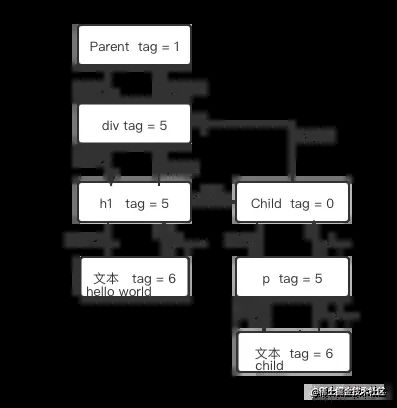一 引沿
Fiber 架构是React16中引入的新概念,目的就是解决大型 React 应用卡顿,React在遍历更新每一个节点的时候都不是用的真实DOM,都是采用虚拟DOM,所以可以理解成fiber就是React的虚拟DOM,更新Fiber的过程叫做调和,每一个fiber都可以作为一个执行单元来处理,所以每一个 fiber 可以根据自身的过期时间expirationTime,来判断是否还有空间时间执行更新,如果没有时间更新,就要把主动权交给浏览器去渲染,做一些动画,重排( reflow ),重绘 repaints 之类的事情,这样就能给用户感觉不是很卡。
二 什么是调和
调和是一种算法,就是React对比新老虚拟DOM的过程,以决定需要更新哪一部分。
三 什么是Filber
Fiber的目的是为了让React充分利用调度,以便做到如下几点:
- 暂停工作,稍后再回来
- 优先考虑不同类型的工作
- 重用以前完成的工作
- 如果不再需要,则中止工作
为了实现上面的要求,我们需要把任务拆分成一个个可执行的单元,这些可执行的单元就叫做一个Fiber,一个Fiber就代表一个可执行的单元。
一个Fiber就是一个普通的JS对象,包含一些组件的相关信息。
function FiberNode(){
this.tag = tag; // fiber 标签 证明是什么类型fiber。
this.key = key; // key调和子节点时候用到。
this.type = null; // dom元素是对应的元素类型,比如div,组件指向组件对应的类或者函数。
this.stateNode = null; // 指向对应的真实dom元素,类组件指向组件实例,可以被ref获取。
this.return = null; // 指向父级fiber
this.child = null; // 指向子级fiber
this.sibling = null; // 指向兄弟fiber
this.index = 0; // 索引
this.ref = null; // ref指向,ref函数,或者ref对象。
this.pendingProps = pendingProps;// 在一次更新中,代表element创建
this.memoizedProps = null; // 记录上一次更新完毕后的props
this.updateQueue = null; // 类组件存放setState更新队列,函数组件存放
this.memoizedState = null; // 类组件保存state信息,函数组件保存hooks信息,dom元素为null
this.dependencies = null; // context或是时间的依赖项
this.mode = mode; //描述fiber树的模式,比如 ConcurrentMode 模式
this.effectTag = NoEffect; // effect标签,用于收集effectList
this.nextEffect = null; // 指向下一个effect
this.firstEffect = null; // 第一个effect
this.lastEffect = null; // 最后一个effect
this.expirationTime = NoWork; // 通过不同过期时间,判断任务是否过期, 在v17版本用lane表示。
this.alternate = null; //双缓存树,指向缓存的fiber。更新阶段,两颗树互相交替。
}type 就是react的元素类型
export const FunctionComponent = 0; // 对应函数组件
export const ClassComponent = 1; // 对应的类组件
export const IndeterminateComponent = 2; // 初始化的时候不知道是函数组件还是类组件
export const HostRoot = 3; // Root Fiber 可以理解为跟元素 , 通过reactDom.render()产生的根元素
export const HostPortal = 4; // 对应 ReactDOM.createPortal 产生的 Portal
export const HostComponent = 5; // dom 元素 比如
export const HostText = 6; // 文本节点
export const Fragment = 7; // 对应
export const Mode = 8; // 对应
export const ContextConsumer = 9; // 对应
export const ContextProvider = 10; // 对应
export const ForwardRef = 11; // 对应 React.ForwardRef
export const Profiler = 12; // 对应
export const SuspenseComponent = 13; // 对应
export const MemoComponent = 14; // 对应 React.memo 返回的组件
比如元素结构如下:
export default class Parent extends React.Component{
render(){
return
hello,world
child
}
对应的Filber结构如下:
有了上面的概念后我们就自己实现一个Fiber的更新机制
四 实现调和的过程
我们通过渲染一段jsx来说明React的调和过程,也就是我们要手写实现ReactDOM.render()
const jsx = (
hello
React
)
ReactDOM.render(
jsx,
document.getElementById('root')
);
1. 创建FiberRoot
react-dom.js
function createFiberRoot(element, container){
return {
type: container.nodeName.toLocaleLowerCase(),
props: { children: element },
stateNode: container
}
}
function render(element, container) {
const FibreRoot = createFiberRoot(element, container)
scheduleUpdateOnFiber(FibreRoot)
}
export default { render }
参考React实战视频讲解:进入学习
2. render阶段
调和的核心是render和commit,本文不讲调度过程,我们会简单的用requestIdleCallback代替React的调度过程。
ReactFiberWorkloop.js
let wipRoot = null // work in progress
let nextUnitOfwork = null // 下一个fiber节点
export function scheduleUpdateOnFiber(fiber) {
wipRoot = fiber
nextUnitOfwork = fiber
}
function workLoop(IdleDeadline) {
while(nextUnitOfwork && IdleDeadline.timeRemaining() > 0) {
nextUnitOfwork = performUnitOfWork(nextUnitOfwork)
}
}
function performUnitOfWork() {}
requestIdleCallback(workLoop)
每一个 fiber 可以看作一个执行的单元,在调和过程中,每一个发生更新的 fiber 都会作为一次 workInProgress 。那么 workLoop 就是执行每一个单元的调度器,如果渲染没有被中断,那么 workLoop 会遍历一遍 fiber 树
performUnitOfWork 包括两个阶段:
- 是向下调和的过程,就是由 fiberRoot 按照 child 指针逐层向下调和,期间会执行函数组件,实例类组件,diff 调和子节点
- 是向上归并的过程,如果有兄弟节点,会返回 sibling兄弟,没有返回 return 父级,一直返回到 fiebrRoot
这么一上一下,构成了整个 fiber 树的调和。
import { updateHostComponent } from './ReactFiberReconciler'
function performUnitOfWork(wip) {
// 1. 更新wip
const { type } = wip
if (isStr(type)) {
// type是string,更新普通元素节点
updateHostComponent(wip)
} else if (isFn(type)) {
// ...
}
// 2. 返回下一个要更新的任务 深度优先遍历
if (wip.child) {
return wip.child
}
let next = wip
while(next) {
if (next.sibling) {
return next.sibling
}
next = next.return
}
return null
}
根据type类型区分是FunctionComponent/ClassComponent/HostComponent/...
本文中只处理HostComponent类型,其他类型的处理可以看文末的完整代码链接。
ReactFiberReconciler.js
import { createFiber } from './createFiber'
export function updateHostComponent(wip) {
if (!wip.stateNode) {
wip.stateNode = document.createElement(wip.type);
updateNode(wip.stateNode, wip.props);
}
// 调和子节点
reconcileChildren(wip, wip.props.children);
}
function reconcileChildren(returnFiber, children) {
if (isStr(children)) {
return
}
const newChildren = isArray(children) ? children : [children];
let previousNewFiber = null
for(let i = 0; i < newChildren.length; i++) {
const newChild = newChildren[i];
const newFiber = createFiber(newChild, returnFiber)
if (previousNewFiber === null) {
returnFiber.child = newFiber
} else {
previousNewFiber.sibling = newFiber
}
previousNewFiber = newFiber
}
}
function updateNode(node, nextVal) {
Object.keys(nextVal).forEach((k) => {
if (k === "children") {
if (isStringOrNumber(nextVal[k])) {
node.textContent = nextVal[k];
}
} else {
node[k] = nextVal[k];
}
});
}
createFiber.js
export function createFiber(vnode, returnFiber) {
const newFiber = {
type: vnode.type, // 标记节点类型
key: vnode.key, // 标记节点在当前层级下的唯一性
props: vnode.props, // 属性
stateNode: null, // 如果组件是原生标签则是dom节点,如果是类组件则是类实例
child: null, // 第一个子节点
return: returnFiber,// 父节点
sibling: null, // 下一个兄弟节点
};
return newFiber;
}
至此已经完成了render阶段,下面是commit阶段,commit阶段就是依据Fiber结构操作DOM
function workLoop(IdleDeadline) {
while(nextUnitOfwork && IdleDeadline.timeRemaining() > 0) {
nextUnitOfwork = performUnitOfWork(nextUnitOfwork)
}
// commit
if (!nextUnitOfwork && wipRoot) {
commitRoot();
}
}
function commitRoot() {
commitWorker(wipRoot.child)
wipRoot = null;
}
function commitWorker(wip) {
if (!wip) {
return
}
// 1. 提交自己
const { stateNode } = wip
let parentNode = wip.return.stateNode
if (stateNode) {
parentNode.appendChild(stateNode);
}
// 2. 提交子节点
commitWorker(wip.child);
// 3. 提交兄弟节点
commitWorker(wip.sibling);
}
五 总结
- Fiber结构,Fiber的生成过程。
- 调和过程,以及 render 和 commit 两大阶段。
